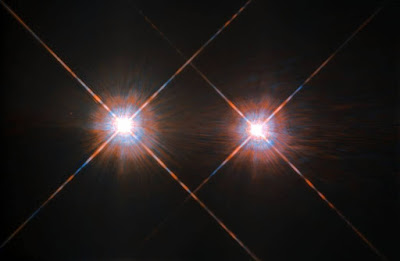Exoplanet round Proxima
Back in December 2018, I wrote about the trinary star system of Alpha Centauri (see photo). The star you can't see, Alpha Centauri C, is a bit overlooked, even though it's the closest star to the Earth (apart from the Sun, of course). It's more commonly known as Proxima Centauri.

Planets are typically named after the star they orbit. The star itself is given the suffix "a", and so the first planet discovered has been named Proxima Centauri b.
Of course, if Proxima is more properly called Alpha Centauri C, then shouldn't the planet really be called Alpha Centauri C a?
All that aside, researchers now have evidence that there may be a second planet in orbit around Proxima.
We'll call this Proxima Centauri c.
There are a few ways of finding exoplanets. A lot are discovered using changes in luminance resulting from eclipses, but these ones were found using the "radial velocity" method.
Imagine tying two balls together using a string, and then tossing them both in the air. They rotate around each other as they fly. However, can you say that one ball is the centre of the system? Not really. The balls both rotate around a point between them - this is called the centre of gravity, or barycentre, of the system. Even if one ball is a lot heavier than the other, it doesn't stay still. The heavy ball still wobbles about a bit.
These wobbles are evidence of orbiting planets. Regular wobbles are an indication of a single planet, more complex wobbles might indicate more planets. To detect more complex wobbles you need a combination of great observations and lots of maths!
So, what is the next step? NASA plans to launch a new space-based telescope, the James Webb, in 2021. Astronomers are hoping that this new instrument will be able to directly observe the planets that orbit Proxima.
That's a photo I want to see!
Comments
Post a Comment